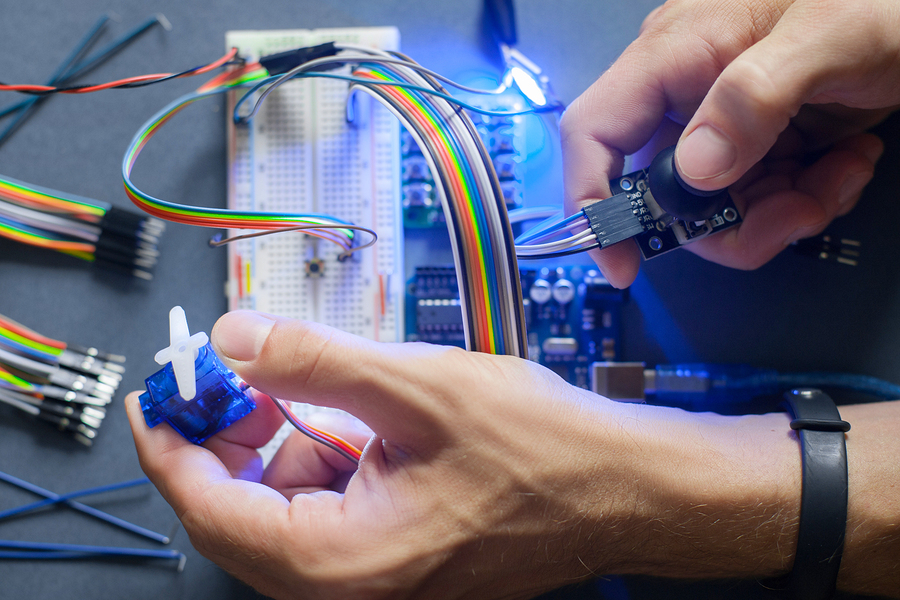
Robohub.org
Robohub roundtable: Why do robotics crowdfunding projects fail?
In this Robohub roundtable edition, we are joined by Sabine Hauert, Kassie Perlongo, John Payne, Audrow Nash, Yannis Erripis, with commentary by Andra Keay and Travis Deyle, to discuss the viability, practicality, and (to a degree) healthy scepticism when it comes to robotic crowdfunding. While there have been a number of successful crowdfunded campaigns, there’s no question others are failing to live up to their hype. Should we be holding crowdfunding, especially crowdfunding for robots, to a higher standard?
It begins with good intentions. And as eager, supportive, tech-minded fans, we want to believe. The video marketing, graphics, and technology all look enticing. The prototype when in mass production seems affordable. We, as crowdfunding investors, are intrigued. The campaign does well — congrats, you’ve made it happen!
Some campaigns don’t even make it that far. According to Kickstarter’s stats, only 44 percent of projects meet their funding goal. Of roughly 60,000 unsuccessful projects, nearly 40,000 failed to reach even 20 percent of their goal. Some projects crash-and-burn by over promising and under delivering. Others do make it through crowdfunding, only to lose steam in the manufacturing process.
Why does this seem to happen? Is there a better formula, or better way to future-proof robotic crowdfunding campaigns to prevent it from happening? Or do we call it what it is: a high-risk investment, a gamble. And investments, even robot ones, can fail.
Being honest and truthful is a crucial factor, according to the Roundtable. “You have to be truthful to your customers,” said Yannis. “It’s acceptable to present something as a prototype. You can say: ‘we didn’t have a working camera at the time.’ But, it’s important to not deceive your funders.”
“It is incredibly difficult to design and produce robots,” said Sabine. “It’s not necessarily about getting funded, as we’ve seen in previous examples, it’s about being able to deliver what you promise. Sometimes hype is necessary to get the funding. But there’s a bit of a vicious cycle in which you need to have great marketing, but still need to be able to deliver,” she said.
Understandably, people feel cheated if a crowdfunded project shuts down. One example recently involved CyPhy Works and their six-rotor LVL 1 drone campaign. Despite an incredibly successful Kickstarter raising nearly $900,000 in 2015, plus a $22 million boost from Bessemer Venture Partners, they decided to close and refund Kickstarter investors April 2016 stating (via their Kickstarter):
“After a successful KickStarter tour featuring showings at The White House, TechCrunch Disrupt, DARPA Robotics Challenge and countless flights around the US, CyPhy Works LVL1 Kickstarter has come to an end. We were unable to make the even a delayed delivery schedule due to the maturity of the sourced video components, especially EIS (Electronic Image Stabilization). All money and associated credit card and Kickstarter fees were returned.
LVL 1 was the first gimbal-free hexacopter enabling true-level flight, a user-friendly geofence capability, and real-time photo sharing. This Kickstarter campaign demonstrated the market pull shattered its $250,000 goal reaching almost $900K in backing.”
Listen to Robots Podcast #184: CyPhy LVL 1 Drone, with Helen Griener
Funder James, on Kickstarter, commented: “[they] deceived us to use our money to get to where they need to be which is a global interest for large investors or buyers.” Adding that “[it was] such a shame for such a soundly great team of experts” and feeling like “it left with nothing, absolutely NOTHING.”
Funder Richard Whitehead echoed similar thoughts, saying it felt like “a distinct lack of respect for their backers.”
A Twitter post by Helen Greiner on April 5, 2016, confirmed the Kickstarter campaign closure was due to “component sourcing delays” and that it “didn’t seem right to make folks wait til 2017.”
Unrealistic timeframes and hardware startup concerns
So is the real issue unpredictability with components and timeframes? In CyPhy’s case, they cancelled the project due to a delay in the availability of a component. This is not the first time a company has needed more time to complete a project.
Jibo is experiencing issues with timeframes being pushed back, as they have delayed their initial December 2015 release to March/April 2016, and now October 2016.
Now, in an email update to its international backers Jibo writes they will not be able to ship outside the U.S. and Canada, saying: “After exploring all the options, we have come to the conclusion that we will not be able to deliver Jibo to your country”, adding this is because the bot “won’t function up to our standards in your country”.
It’s a bit like the chicken and egg philosophy. On the one hand, crowdfunding should help bolster and encourage start-up innovation. On the other hand, setting unrealistic deadlines could mean alienating and upsetting funders, possibly even damaging your brand. Is there any way to maximise a carefully constructed balance between the two?
“There’s a leap of faith on the part of the backers,” said Kassie. “Some of the campaigns may not even have long-term plans. Are we, as funders, asking for too much and stifling creative innovation?”
“There’s a degree of underestimation, so it’s crucial for [backers] to understand the risks,” said Audrow. “For example, [in our robots podcast], we try to ask the hard questions. Most likely if the company has thought about it, they should be able to articulate appropriate answers about their campaign.”
Another example is with AirDroids, a drone that was said to have the “longest flight time of any multicopter under $500,” as it became a victim of its own success after their Kickstarter project resulted in 20 times more orders than they anticipated, and couldn’t keep up with the manufacturing process. Despite sending some units out to backers, they eventually shut down. This can be viewed as yet another cautionary tale.
Ben Einstein, founder and VC at Bolt.io, provided some great advice on hardware startups looking to crowdfund, “Kickstarter is very appealing but extremely dangerous if you don’t use it correctly. You are amplifying all the decisions you made — in a cowboy style with long shadows everywhere. You’re broadcasting to the world and you haven’t figured out what your retail price is going to be, what your bottom-line costs are, how and where will you manufacture, and so on. Go through product development and early manufacturing first, and then use Kickstarter to launch. That works much better.”
“Kickstarter is increasingly seen as ‘risky’ by many founders,” said Travis Deyle. “Like it or not, recent failures make people inherently skeptical. The skepticism and cheapening of your brand will rub off on your company, by association. Also, the signalling effect this has on your product (eg. for market segmentation) matters a lot,” he says.
“I rarely hear crowdfunding discussed as a go-to option in startup circles anymore,” said Travis. “But to be fair, it seems more like early-stage startups are increasingly moving away from consumer hardware. Even the big publicly-traded consumer hardware companies are suffering right now — eg. GoPro is down 80% this year & FitBit is down 60% this year. Many of the big drone companies (eg. 3DR & DJI) are also transitioning away from the consumer space.”
Is there a model or “start-up style” of success for people to follow?
If there’s something practical that be taken away from these cautionary tales it’s that hardware delays are, to a certain extent, to be expected. But, “if you are promising one thing and cannot deliver on that promise, this can be viewed as incredibly deceptive,” said Yannis.
Read more: Mecha Monsters
So, what is good practice for startups? “A good example is Reach Robotics, educational monsters,” said Sabine. “It is a hugely complex platform to design. They decided not to crowdfund because they felt that they needed to figure out how to produce it. They needed a good extra year and half, and they haven’t launched it yet, to figure out how they were going to build it.”
We reached out to Silas Adekunle, Co-founder and CEO for Reach Robotics, for a comment and he offered this advice: “I think more hardware startups owe it to the consumers and the startup community in general to do their due diligence on how to manufacture their product fully before offering it for sale. This will help with consumer confidence issues that we are now seeing in hardware startups.”
While there’s no way to be 100% sure, the Roundtable has come up with a checklist that start-ups may find valuable. Please bear in mind this isn’t inclusive, nor should it be used as the only means to crowdfund, but could provide a valuable guide prior to introducing your campaign to the world. We also recommend reading Hardware by the numbers, by Ben Einstein:
Checklist (a guide, of sorts) for future robotic crowdfunders:
- Do you have a fully working prototype?
- Do you know how to produce said prototype? How much will this cost?
- Is the prototype robust?
- If you have a marketing video, is everything you are showing in your video doable with your prototype?
- Who is your target market? Is that clear in your campaign?
- Do you have beta testers in the field? What have they said about your product?
- Do you have a clear path to production and distribution at scale?
- Does your project contribute to the advancement of robotic technology? Is that clear in your campaign?
- What happens if an angel funder or venture capital fund takes equity in exchange for putting money into the project? Is that transparent in your campaign?
- (Should go without saying) Are you being clear with the language you are using in your campaign (ie. not a lot of marketing spin?)
Please note the checklist doesn’t include things necessary for a successful campaign, just for building a successful product.
“Being able to build a successful product is just the start of the crowdfunding journey,” says Andra. “You can’t rely on a ‘build it and they will crowdfund it‘ approach. Running a successful campaign these days can involve a significant investment of funds, time and the skills of many experienced marketing professionals, from writers and videographers to community managers and PR specialists. A good rule of thumb is to have 33% of your campaign funds already lined up ahead of launch, so as to be able to hit strong milestones in the first days of your campaign.”
“Crowdfunding is just an amplifier, not an investor or a magic remedy,” she said.
Should companies crowdfund?
“It does provide good klout, getting the word out there,” said Sabine.
“It does show traction to raise money, plus, it’s a way to get interest-free “debt” financing to fund manufacturing and inventory,” said Travis.
While one can make a clear argument that it is a case of “buyer beware” (crowdfunding = investment, and investments are inherently risky) there’s also the way crowdfunding platforms, like Kickstarter, is currently set up as a business model that could be problematic for hardware specific projects.
Tech journalist Mark Harris, in his piece on Medium, says that: “Kickstarter, and other crowdfunding platforms, should reconsider the way that they deal with projects involving complex hardware, massive overfunding, or large sums of money. There should be better mechanisms to identify weak projects before they fund, as well as new processes to provide mentorship, support and expert advice to newly-funded projects.”
Maybe he’s right.
To our readers: What do you think? Is our guide a fair representation? Anything else you think we should add?
Read some of our previous Robohub roundtables below:
- Robohub roundtable: Job loss through automation, Foxconn controversy
- Robohub roundtable: Why is it so difficult to define ‘robot’?
- Robohub roundtable: Robotics and space exploration
See all the latest robotics news on Robohub, or sign up for our weekly newsletter.
tags: c-Business-Finance, Robohub roundtable





